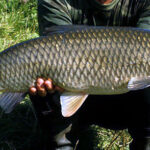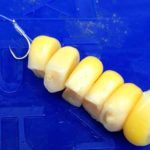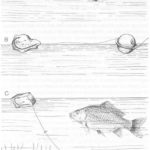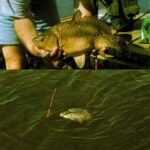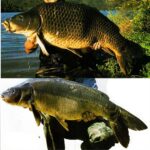Z jakimi przynętami na karpia.
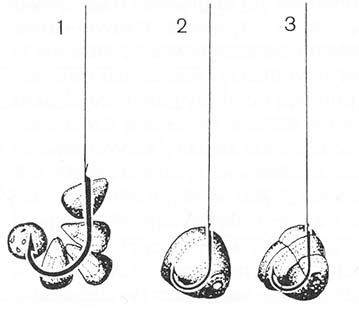 W wodach mulistych stosujemy przynęty odciążone: ziarnka kukurydzy odciążamy za pomocą kuleczki ze styropianu (1), sprasowany kawałek rogalika (2) pewniej trzyma się na haczyku przywiązany cienką nitką (3).
W wodach mulistych stosujemy przynęty odciążone: ziarnka kukurydzy odciążamy za pomocą kuleczki ze styropianu (1), sprasowany kawałek rogalika (2) pewniej trzyma się na haczyku przywiązany cienką nitką (3).
W ostatnim czasie sprawa przynęt do połowu karpia stała się przedmiotem dyskusji, a także licznych eksperymentów. Nikt nie ośmieli się podawać w wątpliwość rangi problematyki przynęt, lecz na podstawie praktyki wędkarskiej można postawić pytanie, czy naprawdę trzeba z tego tworzyć wiedzę tajemną? Odpowiedzi mogą być różne, ale nie łudźmy się, że uda się nam dotrzeć do obiektywnej prawdy. Gdybyśmy widzieli w karpiu wyłącznie wybrednego smakosza, który szukając pokarmu świetnie orientuje się za pomocą wrażliwego aparatu smakowego i węchowego, to nacisk kładziony na dobór przynęt byłby w pełni uzasadniony. Co więcej, w takim przekonaniu utwierdzają nas niektóre praktyki mające miejsce za granicą, gdzie wyrabia się szeroki asortyment przynęt specjalistycznych – przeznaczonych tylko do połowu określonych grup ryb. Naszym zamiarem jednak nie jest podawanie czegokolwiek w wątpliwość; pozwólmy „przemówić” zestawieniu 834 połowów karpia z różnych wód europejskich.
Gdybyśmy polegali wyłącznie na danych statystycznych, wnioski dotyczące skuteczności poszczególnych przynęt byłyby jasne. Prawie 45% udział kukurydzy w połowach nie wymaga komentarza, podobnie też wymowny jest 25% udział ziemniaków i ponad 10% ciast. Pozostałe przynęty (z wyjątkiem dżdżownic) moglibyśmy, tak rozumując, uważać za doraźne, awaryjne rozwiązanie. W rzeczywistości problem doboru odpowiedniej przynęty jest bardziej złożony, a wyniki zestawienia można uznać pod pewnymi względami za mylące. Mamy tu na myśli na przykład to, że skuteczność niektórych przynęt w zależności od lokalnych warunków osiąga niekiedy wartości skrajne. Wyraźnie dotyczy to zwłaszcza kukurydzy, dzięki której na Węgrzech odnosi się wprost wspaniałe sukcesy – aż 63% połowów, podczas gdy w NRD kukurydza zawodzi na całej linii (4% połowów).
Podobnie kształtuje się również skuteczność chleba w Czechach i Polsce. W zasadzie powinniśmy jednak cieszyć się z diametralnie różnego działania poszczególnych przynęt, ponieważ jest to dowód na grymaśność karpia w wyborze potrawy. Tak więc z doboru przynęt do jego połowu nie ma sensu robić nauki za wszelką cenę.
Skuteczność poszczególnych przynęt
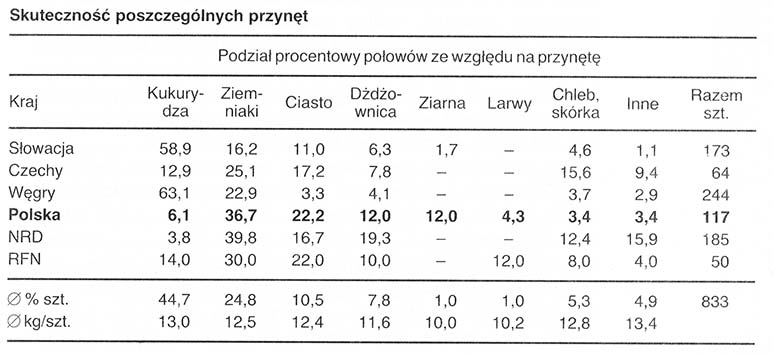
Udział kukurydzy w połowach jest bardziej zróżnicowany dzięki połowom na ciasto, którego głównym składnikiem jest z reguły zmielona kukurydza.
Z powodu zrównoważonych efektów można najwyżej cenić ziemniaki (gotowane), przysmak karpi zwłaszcza w niemieckich (38%) i polskich (37%) wodach. Pouczające są też dane dotyczące Węgier, gdzie większość z 23% ryb tego gatunku złowionych na ziemniak pochodzi z Balatonu, z miejsc, w których pobliżu znajdują się restauracje (zanęca się i łowi na resztki jedzenia). Jedna z najbardziej naturalnych przynęt
– dżdżownica (zaliczamy tu zarówno rosówki, jak i czerwone robaki itp.) w świetle naszego zestawienia nie straciła wprawdzie nic ze swej uniwersalności, ponieważ jej skuteczność jest wyjątkowo wyrównana, ale jej całkowity udział w połowach jest nieproporcjonalnie niski. Przyczyną jej mniejszej skuteczności może być także i to, że chętnie zajmują się nią mniejsze rybki, ale zwłaszcza wiosną ma ona spore znaczenie.
Podobnie rozpowszechnionymi przynętami są kasze i różnego typu ciasta, lecz ich 10% udział w połowach jest zdumiewająco niski. Przygotowanie ich jest przecież jeszcze bardziej pracochłonne niż przygotowanie innych przynęt; co więcej można do nich dodawać co komu przyjdzie do głowy, a nawet urozmaicać kolorystycznie. Z pozostałych rzadziej stosowanych przynęt sprawdziły się np.: ziarna zbóż (parzona pszenica, pęczak), rośliny strączkowe (groch, fasola, bób), owoce, białe robaki, robaki mączne, makaron kolanka, a nawet znaczna część karpi złowiona została na błystkę, żywca (na Węgrzech 23 kilowy, rekordowy), filecik. Nie ma sensu analizować tych pojedynczych przypadków drapieżności karpia, od czasu do czasu tak się po prostu zdarza.
